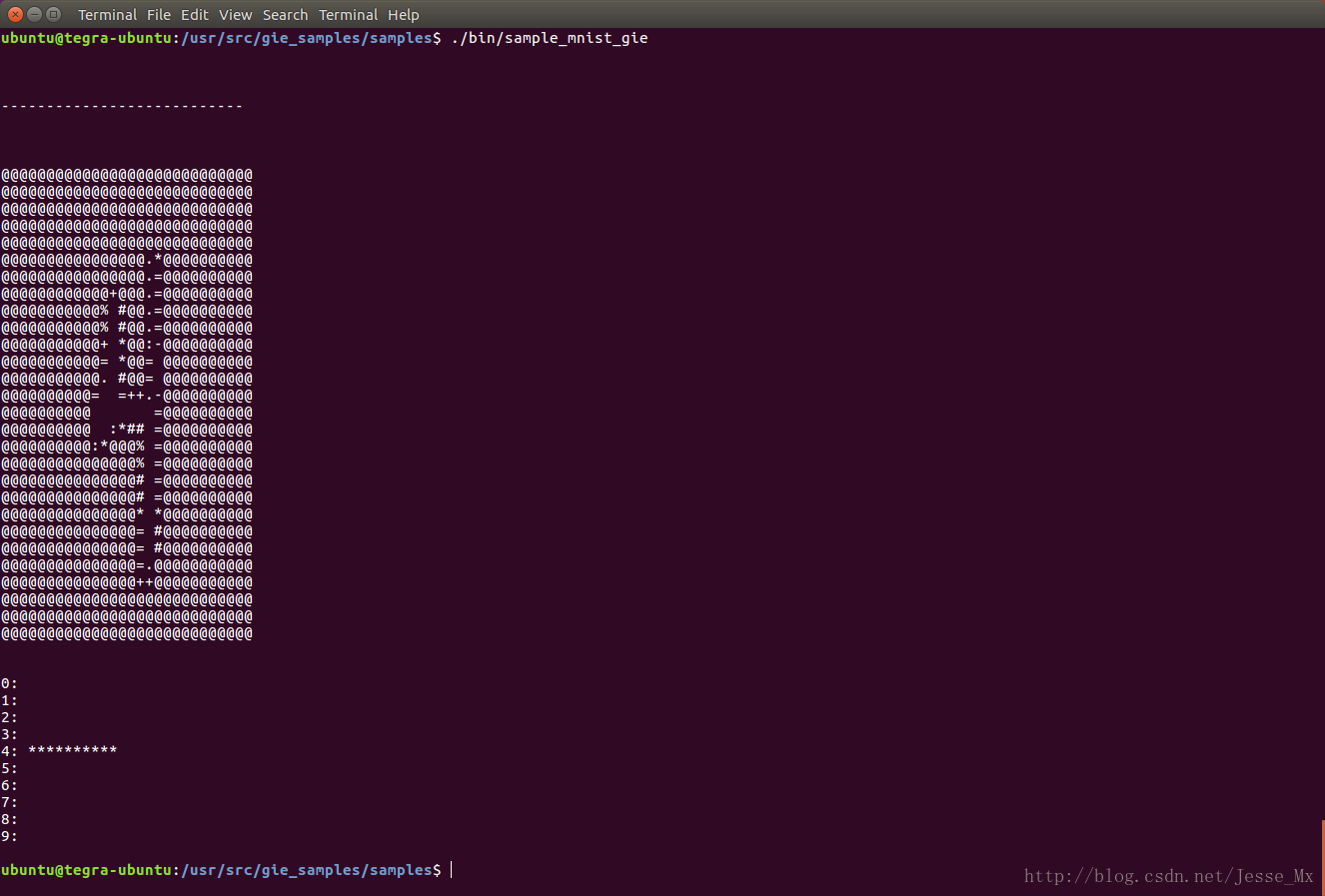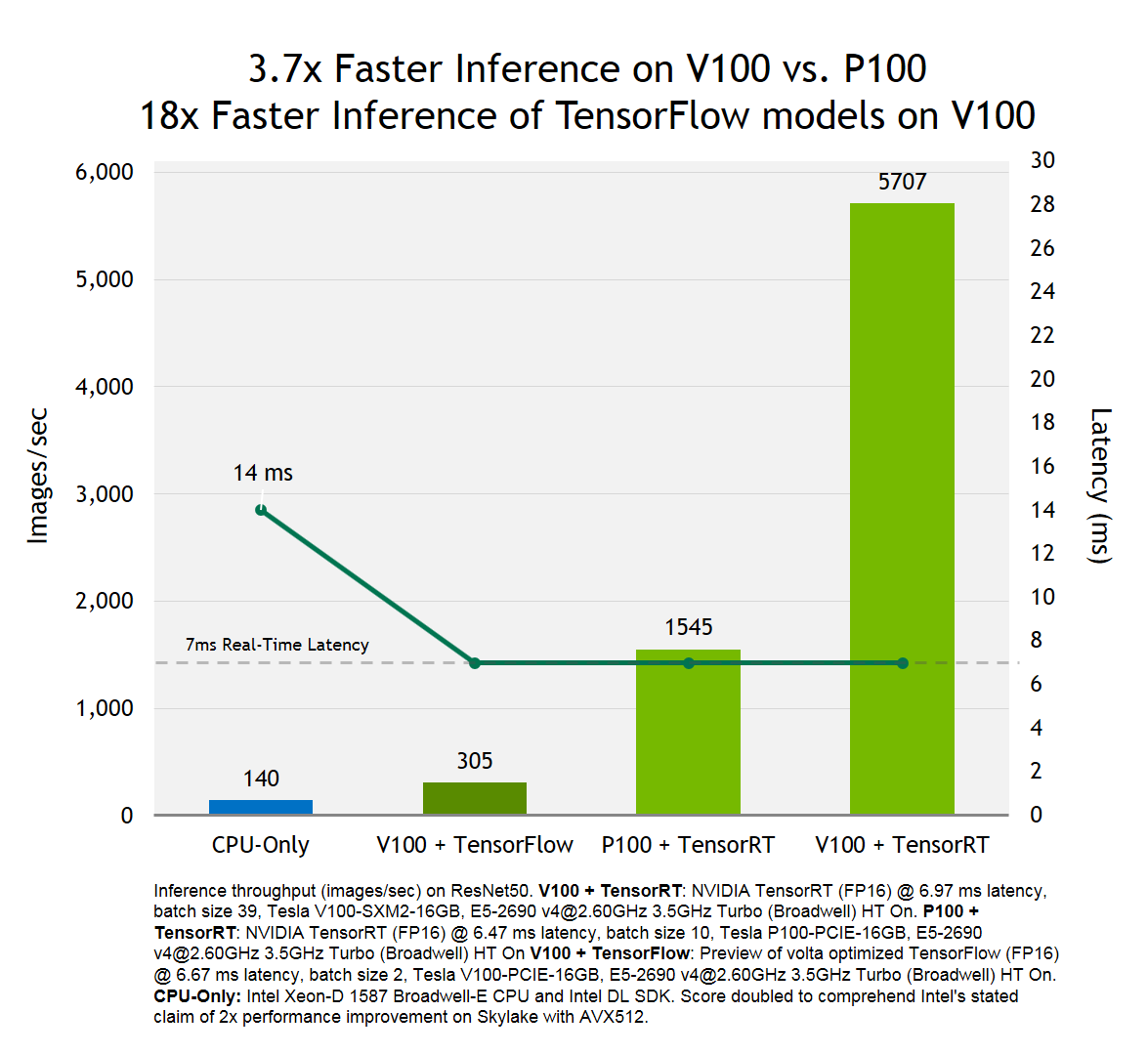官网:https://developer.nvidia.com/tensorrt
作用:NVIDIA TensorRT™ is a high-performance deep learning inference optimizer and runtime that delivers low latency, high-throughput inference for deep learning applications. TensorRT can be used to rapidly optimize, validate, and deploy trained neural networks for inference to hyperscale data centers, embedded, or automotive product platforms.

(Click to Zoom)
Developers can use TensorRT to deliver fast inference using INT8 or FP16 optimized precision that significantly reduces latency, as demanded by real-time services such as streaming video categorization on the cloud or object detection and segmentation on embedded and automotive platforms.
With TensorRT developers can focus on developing novel AI-powered applications rather than performance tuning for inference deployment. TensorRT runtime ensures optimal inference performance that can meet the most demanding latency and throughput requirements.
TensorRT can be deployed to Tesla GPUs in the datacenter, Jetson embedded platforms, and NVIDIA DRIVE autonomous driving platforms.
What's New in TensorRT 3?
TensorRT 3 is the key to unlocking optimal inference performance on Volta GPUs. It delivers up to 40x higher throughput in under 7ms real-time latency vs. CPU-Only inference.
Highlights from this release include:- Deliver up to 3.7x faster inference on Tesla V100 vs. Tesla P100 under 7ms real-time latency
- Optimize and deploy TensorFlow models up to 18x faster compared to TensorFlow framework inference on Tesla V100
- Improved productivity with easy to use Python API
Learn more about how to get started with TensorRT 3 in the following technical blog posts:
见:https://stackoverflow.com/questions/41142284/run-tensorflow-with-nvidia-tensorrt-inference-engine 可以知道已经支持导入TensorFlow的模型
TensorRT 3.0 supports import/conversion of TensorFlow graphs via it's UFF (universal framework format). Some layer implementations are missing and will require custom implementations via IPlugin interface.
Previous versions didn't support native import of TensorFlow models/checkpoints.
from:http://blog.csdn.net/jsa158/article/details/53944159
TensorRT介绍 TensorRT 现在是inference 精度最高,速度最快的,而且在不断的改进过程中,在保证软件精度的同时,不断提高速度;TensorRT只能用来做Inference,不能用来做train;
1、TensorRT的需要的文件 需要的基本文件(不是必须的) 1>网络结构文件(deploy.prototxt) 2>训练的权重模型(net.caffemodel) TensorRT 2.0 EA版中的sampleMNISTAPI和TensorRT 1.0中的sampleMNISTGIE 几乎没有变化,就是不使用caffemodel 文件构建network 的例子。 2、TensorRT支持的层 Convolution: 2D Activation: ReLU, tanh and sigmoid Pooling: max and average ElementWise: sum, product or max of two tensors LRN: cross-channel only Fully-connected: with or without bias SoftMax: cross-channel only Deconvolution 对于TensorRT 不支持的层,可以先将支持的层跑完,然后将输出作为caffe的输入,用caffe再跑,V1不支持TensorRT 和caffe同时工作,V2支持。(例子NVIDIA正在做,后期可能会上传github) 3、TensorRT 处理流程 基本处理过程:1>caffe model 转化 gie的model,或者从磁盘或者网络加载gie可用的model;2>运行GIE引擎(数据提前copy到GPU中);3>提取结果
三、TensorRT Optimization
使用了很多 优化网络和层计算的方法 内存优化、网络优化,层合并,层删除以及GPU汇编指令,内部函数,提高GPU利用率,减少精度需求,cuDNN优化,根据不同的batchsize设置不同的计算模式或者GPU clock;卷积的优化,使用Winograd(提升3倍) 等算法或者特定硬件方式实现;批量处理尽可能并行处理,在cuda中 使用warp对齐,提高GPU命令命中率,除此还有CPU可以使用,CPU做一部分工作,GPU做一部分工作;
数据布局可以使用半精度FP16 , textute memory , 13% inference speedup 网络优化中,网络的垂直融合,网络的水平融合,级联层可以删掉(concat) 内部使用稀疏矩阵编码
转自:http://blog.csdn.net/amds123/article/details/72234167?locationnum=13&fps=1
项目地址:
前言
TensorRT(GIE)是一个C++库,适用于Jetson TX1和Pascal的显卡(Tesla P100, K80, M4 and Titan X等),支持fp16特性,也就是半精度运算。由于采用了“精度换速度”的策略,在精度无明显下降的同时,其对inference的加速很明显,往往可以有一倍的性能提升,而且还支持使用caffe模型。目前网上关于TensorRT的介绍很少,这里博主尝试着写一些,有空还会继续补充。
TensorRT简介
TensorRT目前基于gcc4.8而写成,其独立于任何框架。对于caffe而言,TensorRT是把caffe那一套东西转化后独立运行,能够解析caffe模型的相关工具叫做 NvCaffeParser,它根据prototxt文件和caffemodel权值,转化为支持半精度的新的模型。
目前TensorRT 支持caffe大部分常用的层,包括:
- Convolution(卷积层), with or without bias. Currently only 2D convolutions (i.e. 4D input and output tensors) are supported. Note: The operation this layer performs is actually a correlation, which is a consideration if you are formatting weights to import via GIE’s API rather than the caffe parser library.
- Activation(激活层): ReLU, tanh and sigmoid.
- Pooling(池化层): max and average.
- Scale(尺度变换层): per-tensor, per channel or per-weight affine transformation and exponentiation by constant values. Batch Normalization can be implemented using the Scale layer.
- ElementWise(矩阵元素运算): sum, product or max of two tensors.
- LRN(局部相应归一化层): cross-channel only.
- Fully-connected(全连接层) with or without bias
- SoftMax: cross-channel only
- Deconvolution(反卷积层), with and without bias
不支持的层包括:
- Deconvolution groups
- PReLU
- Scale, other than per-channel scaling
- EltWise with more than two inputs
使用TensorRT主要有两个步骤(C++代码):
- In the build phase, the toolkit takes a network definition, performs optimizations, and generates the inference engine.
- In the execution phase, the engine runs inference tasks using input and output buffers on the GPU.
想要具体了解TensorRT的相关原理的,可以参看这篇官方博客:
这里暂时对原理不做太多涉及,下面以mnist手写体数字检测为例,结合官方例程,说明TensorRT的使用步骤。
TensorRT运行caffe模型实战
获取TensorRT支持
首先,Jetson TX1可以通过Jetpack 2.3.1的完全安装而自动获得TensorRT的支持,可参考博主之前的教程。TX1刷机之后,已经添加了一系列的C++运行库去支持TensorRT,如果掌握API的话,写一个C++程序就可以实现功能。
没有TX1,只有Pascal架构的显卡(如TITAN X),那也能感受TensorRT的效果,方法是去官网申请资格,需要详细说明自己的研究目的,一般经过一两次邮件沟通后就能通过。博主目前已经获得TensorRT 1.0和2.0的测试资格,有机会也会进行TITAN X的TensorRT测试。
运行官方例程
这里,博主就先以Jetson TX1为例,看看官方自带的例程是如何运行的。自带例程的地址是:/usr/src/gie_samples/samples,我们打开文件夹,发现如下文件:
其中,data文件夹存放LeNet和GoogleNet的模型描述文件和权值,giexec文件夹是TensorRT通用接口的源代码,剩下的文件夹是特定网络的接口源代码。Makefile是配置文件,在gie_sample文件夹位置打开终端,输入sudo make就能完成编译,生成一系列可执行文件,存放在bin文件夹中,那我们就来看看bin文件夹的内容:
首先测试giexec文件:
cd /usr/src/gie_samples/samples./bin/giexec#得到如下的使用方法:Mandatory params: --model=Caffe model file --deploy= Caffe deploy file --output= Output blob name (can be specified multiple times Optional params: --batch=N Set batch size (default = 1) --device=N Set cuda device to N (default = 0) --iterations=N Run N iterations (default = 10) --avgRuns=N Set avgRuns to N - perf is measured as an average of avgRuns (default=10) --workspace=N Set workspace size in megabytes (default = 16) --half2 Run in paired fp16 mode - default = false --verbose Use verbose logging - default = false --hostTime Measure host time rather than GPU time - default = false --engine= Generate a serialized GIE engine
- 1
- 2
- 3
- 4
- 5
- 6
- 7
- 8
- 9
- 10
- 11
- 12
- 13
- 14
- 15
- 16
- 17
- 18
二者比较的话,发现使用半精度的话,确实速度确实上去了一些,但是提升幅度一般,大约快了50%的样子。当然,博主认为这个mnist例子太简单了,可能并不具备太大的说服力,大家可以参看官方给出的加速效果图。
那么剩下的几个可执行程序分别有什么用呢?我们还是来一一试验,结果如图:
./bin/sample_mnist 
./bin/sample_mnist_gie

以上二者并没有带什么参数,貌似都在进行随机图片的检测,具体区别需要看源代码。
./bin/sample_googlenet

这个也没有参数可选,只是跑了一遍,最后得出一个时间。
写在后面
TX1自带的TensorRT例程操作起来并不难,博主认为,其最重要的价值在于那些cpp源代码,只有参考这些官方例程,我们才能独立写出C++代码,从而加速自己的caffe模型。giexec.cpp总共代码300多行,还是有点长的,虽然有些注释,但是如果没有仔细研究其API的话,里面的很多函数还是不会用。TensorRT的API文档内容有点多,本人暂时没空研究。
拥有Jetson TX1的小伙伴可以打开/usr/share/doc/gie/doc/API/index.html查看官方API文档,我这里连同例程源代码一起,都上传到了csdn,有兴趣者可以下载来看看。(貌似离开了TX1,API文档效果不佳)
有小伙伴在我之前的博客问道,TensorRT能不能加快目标检测框架如SSD的运行速度呢。博主所知道的是,目前还不能。因为现在的TensorRT有较大的局限性,仅支持caffe模型转化后进行前向推理(inference),训练部分还不支持。而且在我看来,目前应用99%都是在图片分类上,比如实现一下Alexlet或者GoogleNet模型的半精度转化,这样就把图片分类的速度提升一倍。由于SSD等目标检测框架含有特殊层以及结构复杂的原因,现有的那些TensorRT函数根本无法去进行转化和定义。
不过Nvidia官方已经开始重视目标检测这一块了,博主和Nvidia技术人员的邮件往来中,获悉未来的TensorRT将会支持Faster RCNN以及SSD,他们已经在开发中了,相信到时使用Jetson TX1进行目标检测,帧率达到10fps以上不是梦。
You mentioned the SSD Single Shot Detector. We are working on SSD right now. I think you’ll find there are some layers needed for SSD that aren’t supported in the versions of TensorRT available through these early release programs. We are adding a custom layer capability to the next version and providing support using that mechanism for Faster R-CNN and SSD.



